Leigh
(Park) House (Later) Leigh Park Hotel
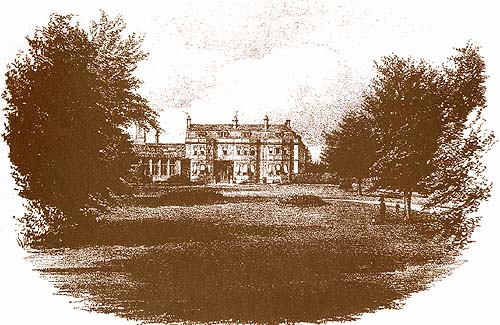
This
distinguished house has a long and complicated history, some of which is quite
difficult to verify. There is no doubt that parts of the original building remain
embedded within the nineteenth century house we see today. But later additions
and alterations have helped to turn the property into an intriguing architectural
puzzle which cannot be fully unravelled in one short article. However, unlike
some of Bradford's other gentlemen's residences which retained their privacy behind
their high walls, Leigh Park House has been open to townsfolk in different ways
throughout the whole of the twentieth century. Newspaper cuttings, articles and
above all personal accounts of Leigh Park as people have known it in its differing
roles over the last 100 years provide some compensation for limitations of evidence
of its proven architectural history.
Since there are many interesting features
to the house, to the families which have occupied it and also in the ways in which
this outlying area of Bradford has changed through the centuries, this is the
first of two articles on Leigh Park House. This one attempts to describe some
of the history of the house and its landscape setting up until the end of the
nineteenth century. Leigh Park House has played a part in the lives of Bradford
people through the twentieth century and this story will appear in a later edition
of the Guardian Angel.
Christopher Scott-Moody, whose parents bought the house
in 1979, produced a most useful booklet on the previous history of the property.
I would also like to acknowledge the painstaking work by Roger Mawby in tracing
the families who once lived at Leigh Park House. Pamela Slocombe's article "Leigh
Park Hotel or Leigh House: History prior to 1800", written for the Wiltshire
Buildings Record files is based on and expands Roger's researches and I appreciate
her permission to draw upon it. Her article (WBR), which has more details of pre-eighteenth
century information than I have room for here, is available in the Local Studies
Library, Wiltshire & Swindon Record Office (WSRO) Trowbridge. Gareth Slater's
detailed work on architectural features is also, as always, most informative and
helpful
Bradford Leigh (or Lye) has been an administrative area within the
Manor of Bradford since Saxon times and, as such, formed part of the property
of the Abbey of Shaftesbury in 1001. Being some distance from mediaeval Bradford
itself, it became a small hamlet set in arable and pasture land and no doubt provided
a useful stopping place along the ancient route up Whitehill and towards Wraxall
and Corsham. We know there was some habitation there by 1351 when the Abbey of
Shaftesbury placed "Thos. Skathloke and Edith, daughter of Roger le Porter
in possession of a messuage in Lygh and Wroxhole within the Manor of Bradford"
(Jones p.242) but exactly what was involved would be difficult to say.
It is
when we get to 1523 that we have a reference to the family which would become
the dominating presence at Bradford Leigh for over 200 years - the Bayleys or
Baileys. In that year, although the Abbey of Shaftesbury was still the overall
owner of the Manor of Bradford, William Bayley of the Ley in the Parish of Bradford,
was in a position to lease out land to William Gunwyn (Jones p.248).
In 1545
John Bayley was one of seven men in the tithing of Ley obliged to pay towards
a national tax intended to help pay for wars with France and Scotland. John Bayley
and three others were assessed at ten shillings each; the rest for lesser sums.
Most unusually, this revenue had to be paid by the collector directly to the "knyght
cofferer of the hinges moost honorable howshold". The tax was somewhat misleadingly
called "the Benevolence" or "Loving Contribution". Spin was
around even in Henry VIII's time.
The Bayleys remained at Bradford Leigh until
the middle of the 18th century. Then followed a succession of different owners.
For the purposes of this article the most significant were Daniel Clutterbuck,
the Rev. Bradney, Miss Isabella Poynder, Lady Swinburne, and Lord Fitzmaurice.
Details from the tenure of Daniel Clutterbuck and the Rev. Bradney (Jones, p.187)
reference the same property back to the ownership of the Bailey family and allow
us to say, with some confidence, that some of Leigh Park House dates back to their
Tudor house. A few ghostly resonances of this early building can probably be found
in the irregular stone paving of the cellar in the central part of the house,
surrounded by thick stone walls with remains of an original window below the present
ground level.part of the property of the Abbey of Shaftesbury in 1001. Being some
distance from mediaeval Bradford itself, it became a small hamlet set in arable
and pasture land and no doubt provided a useful stopping place along the ancient
route up Whitehill and towards Wraxall and Corsham. We know there was some habitation
there by 1351 when the Abbey of Shaftesbury placed "Thos. Skathloke and Edith,
daughter of Roger le Porter in possession of a messuage in Lygh and Wroxhole within
the Manor of Bradford" (Jones p.242) but exactly what was involved would
be difficult to say.
It is when we get to 1523 that we have a reference to
the family which would become the dominating presence at Bradford Leigh for over
200 years - the Bayleys or Baileys. In that year, although the Abbey of Shaftesbury
was still the overall owner of the Manor of Bradford, William Bayley of the Ley
in the Parish of Bradford, was in a position to lease out land to William Gunwyn
(Jones p.248).
In 1545 John Bayley was one of seven men in the tithing of Ley
obliged to pay towards a national tax intended to help pay for wars with France
and Scotland. John Bayley and three others were assessed at ten shillings each;
the rest for lesser sums. Most unusually, this revenue had to be paid by the collector
directly to the "knyght cofferer of the hinges moost honorable howshold".
The tax was somewhat misleadingly called "the Benevolence" or "Loving
Contribution". Spin was around even in Henry VIII's time.
The Bayleys
remained at Bradford Leigh until the middle of the 18th century. Then followed
a succession of different owners. For the purposes of this article the most significant
were Daniel Clutterbuck, the Rev. Bradney, Miss Isabella Poynder, Lady Swinburne,
and Lord Fitzmaurice. Details from the tenure of Daniel Clutterbuck and the Rev.
Bradney (Jones, p.187) reference the same property back to the ownership of the
Bailey family and allow us to say, with some confidence, that some of Leigh Park
House dates back to their Tudor house. A few ghostly resonances of this early
building can probably be found in the irregular stone paving of the cellar in
the central part of the house, surrounded by thick stone walls with remains of
an original window below the present ground level.
until after 1752. Kingsfield
was between Bradford and Woolley.
As already mentioned, the spelling of the
Bailey family name can differ in the various legal documents which record their
long occupation of the Bradford Leigh area. They also often appear as "Taunton
alias Bailey". This specific name also appears on legal documents pertaining
to the Bailey family which was prominent in Holt in the 16th and 17th century.
From this connection we can trace our Baileys of Leigh to other Bailey families
throughout the county, many of whom, as clothiers, became significant landowners
in the West Wiltshire area. Perhaps our most tangible link today with this extended
family is the large panelled monument to William Bailey (1644-1712) which can
be found at the west end of the north aisle of Holy Trinity Church. William's
relationship to the Leigh Baileys is uncertain but it is interesting to learn
that, as a merchant dealing in fine textile fabrics, he was sufficiently important
to produce his own Bradford token. (Carr,p.24).
That the (Tawnton als) Baileys
of Leigh were also important Bradford townspeople in their own right is clear
from Roger Mawby's research at the WSRO where 17th and 18th century documents,
such as taxation records, leases, administration bonds and, eventually, the Poor
Rate Book provide plenty of evidence of their activities especially in the Bradford
Leigh vicinity. Bayleys appear in a list of Wiltshire freeholders made by the
county sheriff in 1607-8 (Wiltshire Archaeological Magazine (WAM) vol.19) and
in about 1613-16 the Earl of Clanricarde sold off a portion of the Bradford estate
to "John Bayley alias Staunton" (Jones p.46). Their births, marriages
and deaths are frequently recorded at Holy Trinity It seems Alice Taunton als
Bailey (bapt. 1615) was the wife of Thomas Lewis, the vicar of Holy Trinity from
1660 - 1710. There are family wills from 1598,1646,1663,1663 and 1684, some of
which contain details of their property, goods and chattels (WBR). Their long
ownership ended in the 1740s when the property was passed on to John Smith, clothier
of Bradford. His father, Nathan Smith, who died circa 1743, had loaned £400
to Robert Bailey and his son, John: money which for reasons unknown was not repaid.
The
next significant owner for our purposes was Daniel Clutterbuck who was paying
the Land Tax assessment on the property by 1788. The Clutterbucks, who have three
memorials in Fig. 2: South Entrance Door.
the chancel of Holy Trinity church
(Carr pp.40-43). were another major Bradford family, related into the Tugwells
and other local clothier families. A1789 deed (quoted by Scott-Moody) states "Mr
Clutterbuck hath bought a house, garden, and lands at Ley. The house is bounded
on the east by an orchard, on the west by the wall of the orchard. On the north
is the paddock called Lower Close and the common of Bradford Leigh. A large close
of the paddock called Home field bounds the house on the south ". Clearly
a wealthy man, Daniel was able to enlarge his grounds in a substantial way in
1797 through the purchase of the 69 acres 2 roods 9 perches of the adjacent Slade
(Sladesbrook) Farm. The now extensive Clutterbuck estate was surveyed by Knapp
the following year and provides us with much detailed information on the house
in its setting (WSRO/G13/402/12). (fig 1).
Much of the house we see today must
be due to Daniel Clutterbuck: the three bow windows of the south front, the south
entrance door with its elaborate fanlight (fig. 2), leading through to the beautiful
oval staircase with inlaid mahogany handrail and decorative plasterwork around
the base of its glass lantern; patterned plaster cornices in other rooms; the
delicate mouldings of the internal window shutters and the overall treatment of
the main block. All this is eloquent of the high standard of design and craftsmanship
that money could buy around 1800.
This 1798 map makes clear something which
would not be immediately obvious to a visitor to the house today — namely
that in the 18th century the entrance to the house was from Bradford and the south.
Thus the approach to the house through the long carriage drive (which entered
the estate approximately where the Sladesbrook/Leigh Park Road mini roundabout
is today) drew the visitor through the private grounds and made the most of the
impressive three-bay fronted south facade (fig 3). Looking across his own extensive
fields with fine views over Bradford to the Bratton hills to the south and the
Malborough Downs to the east, Daniel Clutterbuck must have been a very satisfied
man. Nothing of this Sladesbrook entrance to the estate now remains and no record
of any gateway has come to light. But a gateway was still there when Jack Stafford
was using a remaining outbuilding of Sladesbrook Farm close by. Being a builder
himself, he took careful note of it and has drawn it for us, reproduced here by
Gareth Slater (fig 4).
Jack says
"It was built of Bath stone and was
in very good condition up to the time it was removed in the 1960s. The pillars
consisted of two large blocks with solid caps on top. The curved walls were made
with 6inch high blocks, each one curved to the main curve of each of the side
walls. The flat top stones on each wall were 3 inches thick. The 4ft 6 inch wall
(marked with a cross on my plan) was built with the same stone and topping stones
as was the high wall which at that time stretched from the 1845 chapel in Sladesbrook
right up to Leigh crossroad. The topping stones are called cocks and hens ".
Events
significant for the whole of Bradford occurred in 1818 when various parcels of
land in the different tithings were taken into private ownership through the Bradford
Enclosure Award (WSRO/G13/990/1PC). Several Bradford Leigh landowners benefited
accordingly.
You may have noticed the earlier reference in the Clutterbuck
document quoted above to Bradford Leigh common to the north of the house. Several
early maps (Andrews & Drury 1773) and the first OS map of 1817 (fig 5) show
a small linear common which stretched along the South Wraxall road from about
the Leigh crossroads to just beyond the Plough Inn. In 1818 a (private) "Act
for inclosing lands in the parish of Bradford in Wiltshire" was published
(WSRO/G13/415/140). Due notice of this impending Act had to be given on the church
door of Holy Trinity and on the doors of the chapels at Atworth, Holt and Winsley.
It was also published in the Salisbury & Winchester Journal and the Bath &
Cheltenham Gazette. The Initiators were those "entitled to the Soil of the
Commons and Waste Lands within the said Manor" and included Daniel Clutterbuck.
No doubt a major concern for local people crowding round the church door was —
if the common gets enclosed, what will happen to our Bradford Leigh Fair, always
held at the end of August? The Act took care to reassure inhabitants that the
fair would continue. I cannot resist quoting from this document which is not only
of local interest but also illustrates the spectacular number of verbs the legal
mind felt justified in using to make the point that the enclosure would only take
place.......
".... Provided always nevertheless and be it further Enacted
That nothing herein contained shall extend or be deemed, construed or taken to
impede, alter, prevent, lessen or destroy any Right or Rights of any Person or
Persons whomsoever, to hold, continue, keep and attend the Annual Fair or Mart
usually held on the aforesaid Common called Bradford Leigh, or the Right of the
said Paul Metheun, his Heirs or Assigns, to the Tolls arising or becoming payable
in respect of the said Fair or Mart."
Gee Langdon quotes an announcement
from the Bath Journal August 1756 (GL p.14) describing some of the animals and
goods to be available at that year's fair and ending with the comment "Toll
free as usual". Perhaps Paul Metheun in 1818 would waive his toll but wanted
his right to it reaffirmed in law?
Anyway, the Act was passed and the resultant
apportionment map (WSRO/G13/ 990/2PC) is dated 1821. Apart from 8 small parcels
of land (7 of them in traditional strip form which were presumably apportioned
to local commoners) all the owners of the adjacent fields obtained the common
land which abutted onto their holdings. Daniel Clutterbuck purchased the common
land immediately to the north of his house for £56 and now had direct access
both to the new road to Bath and onto the Leigh crossroads. A natural result was
to be a major rebuild to Leigh House which now could be dramatically turned around
so that its main entrance could be from the north as we see it today.
Daniel
died in 1821 so such major alterations and additions must have taken place during
the ownership of his son, Thomas, or that of Sir Thomas Fellows, the next owner
of the house, or during the longer tenure of the Rev J.H.Bradney the first vicar
of Christ Church, who bought the prope Fig. 6: North Fro
The main change was
the north entrance, with its porch of Tuscan columns, and the extension of the
north front to the west, attaching it to an existing building whose ground floor
is now part of the hotel's kitchen. An elegant stone summer house near the northeast
corner of the house could also belong to this period, as could the entrance lodge
on Leigh Road West.
The Rev. Bradney was a wealthy man and was ready to put
money into the locality. It was during his time that the top of the town began
to take on the aspect familiar to us today. Christ Church was consecrated in 1841,
and in 1847 the National School was built beside it. But the rest of Says Green
(fig. 1) remained in the possession of Leigh House. On the Rev. Bradney's death,
the house and estate came up for auction and so we have a detailed description
of this freehold property on 16 July 1861.
"THE MANSION embraces every
convenience for a Family and contains on the Ground floor, Dining-room, 21ft.
x 16ft 8in.; Drawing-room, 22ft x 16ft. 8in.; Library, 17ft x 16ft 8in.; with
Conservatory adjoining; Kitchen, Butler's Pantry; Servants' Hall, Housekeeper's
Room, and necessary Offices. On the First floor, Boudoir, Eight Bedrooms, Two
Dressing-rooms, Six Servants'Bedrooms, Store Room, China Closets, Two water-closets,
etc. There are also good Wine and Beer-cellars, and Two Larders. OUTSIDE; THE
STABLING COMPRISES Stalls and Loose Boxes for Six Horses; Coachhouse for Four
Carnages; with Bedroom over" Miss Isabella Poynder bought the estate in 1863.
Fifteen years later she had donated the little piece of land in Says Green upon
which the Infants' school was erected. Evidently Miss Poynder took her role of
National School patron seriously and some instances of her kindly concern have
been described by Harold Fassnidge (Fassnidge pp. 74-75.).
By the mid nineteenth
century several other fine gentlemen's residences had sprung up nearby "on
the Bath side of town" — Berryfield House ((currently our Bradford Hospital)
and North Leigh House (now demolished) being the closest. When Miss Poynder died
in 1880 Michael Palmer of Berryfield House seized his chance to increase the acreage
surrounding his own house in a substantial way by purchasing Leigh Park and its
lands for £12,000. What he really wanted was the original Sladesbrook Farm
land bought by Daniel Clutterbuck over eighty years before. Now these same fields
became part of the Berryfield estate.
Having got what he wanted, Mr. Palmer
immediately sold Leigh House, its pleasure grounds and kitchen gardens, now totalling
only 19 acres, to Lady Jane Swinburne, mother of Algernon Swinburne. A letter
which the poet wrote to his partner, Watts, shows that he was at Leigh House in
July 1882, working on an article about Victor Hugo, and again in August 1887.
The content of this second letter (Henderson p.262) suggests that Swinburne, who
had repudiated Christianity and whose health had been undermined by heavy drinking
and other unmentionable excesses, would not have mingled easily in polite Bradford
society. Lady Swinburne put Leigh House on the market in 1888 and, after a brief
interlude, it was bought by the Right. Hon Lord Fitzmaurice on 11 November 1890
for £6,525.
Lord Fitzmaurice made Leigh Park his home until his death
in 1935. He became a generous benefactor to Bradford and was a much loved and
respected figure in the town. As his tenure takes us well into the 20th century
this will be the starting point for my next article. If anyone would like to contribute
their own memories of the property, either as Lord Fitzmaurice's private home,
or as the town hospital or as Leigh Park Hotel, I shall be very pleased to hear
from them.
Margaret Dobson
Further references, mentioned in the text:
Carr,
R., Storied Urns (1998)
Fassnidge, H., Bradford on Avon: Past <& Present
(revised
ed. 1993) Henderson, P., Swinburne, (1974) Jones, W.H. & Jackson J.R., Bradford-Upon-Avon
(1907)
Langdon
Gee, The Year of the Map (1976) Scott-Moody, C, Leigh Park Hotel; A History of
the
House (1984)
Wiltshire and Swindon Record Office (WSRO): Documents ref G13/402,415,
990.
from the
Guardian Angel issue no. 37, Spring 2002
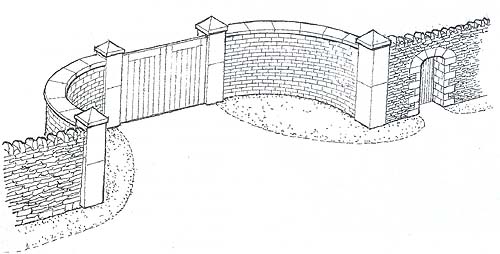
South
Entance Gateway, on Sladesbrook
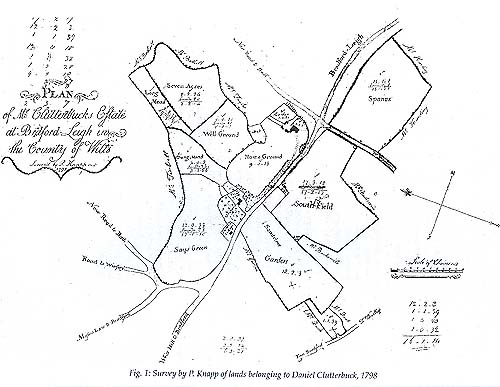
Survey
of P. Knapp of lands belonging to daniel Clutterbuck, 1798
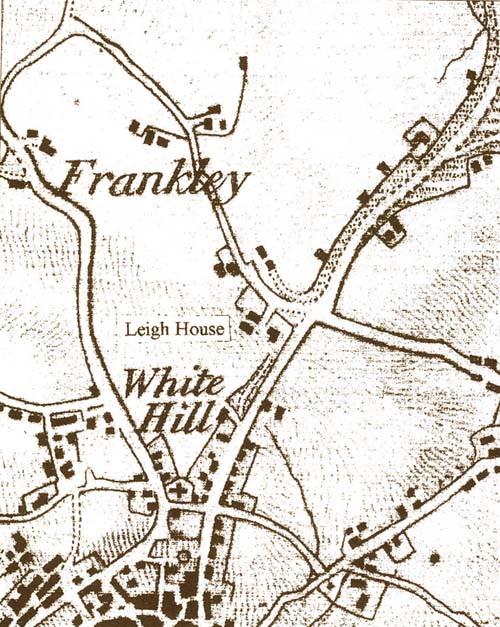
Part
of the first Ordnance Survey Map 1917 (with later revisions)
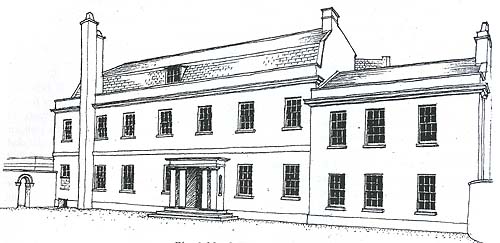
North
Front as it is today